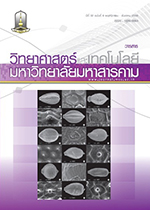ผลสัมฤทธิ์ทางการเรียนวิชาการป้องกันและควบคุมโรค โดยใช้รูปแบบการสอนแบบผสมผสาน เน้นผู้เรียนเป็นศูนย์กลาง นิสิตหลักสูตรสาธารณสุขศาสตรบัณฑิต ชั้นปีที่ 3 คณะสาธารณสุขศาสตร์ มหาวิทยาลัยมหาสารคาม
Main Article Content
Abstract
บทคัดย่อ
การวิจัยกึ่งทดลองเรื่องการศึกษาผลสัมฤทธิ์ทางการเรียนวิชาการป้องกันและควบคุมโรค โดยใช้รูปแบบการสอนแบบผสมผสานเน้นผู้เรียนเป็นศูนย์กลาง กลุ่มตัวอย่าง คือ นิสิตชั้นปีที่ 3 หลักสูตรสาธารณสุขศาสตรบัณฑิต คณะสาธารณสุขศาสตร์มหาวิทยาลัยมหาสารคาม จำนวน 211 คน แบ่งเป็นกลุ่มทดลอง (ห้องเรียนระบบปกติ) จำนวน 95 คน ได้รับการสอนด้วยการสอนแบบผสมผสาน และกลุ่มเปรียบเทียบ (ห้องเรียนระบบพิเศษ) จำนวน 116 คน ได้รับการสอนแบบบรรยาย ดำเนินการศึกษาระหว่าง เดือนตุลาคม 2553 - กันยายน 2554 เก็บรวบรวมข้อมูลโดยใช้แบบสอบถาม สถิติที่ใช้ ได้แก่ ความถี่ ร้อยละ ค่าเฉลี่ยและส่วนเบี่ยงเบนมาตรฐาน และ Paired Samples t-test กำหนดระดับความมีนัยสำคัญทางสถิติ p-value< 0.05
ผลการศึกษา พบว่า กลุ่มทดลองและกลุ่มเปรียบเทียบ ส่วนใหญ่เป็นนิสิตเพศหญิง ร้อยละ 68.42 และ 92.63 ตามลำดับทั้ง 2 กลุ่ม มีเกรดเฉลี่ยหลังการทดลอง > 3.51 ร้อยละ 54.74 และ 37.61 ตามลำดับ ผลสัมฤทธิ์ทางการเรียนวิชาที่ทำการวิจัยของกลุ่มทดลองทั้งก่อนและหลังการทดลอง ภาพรวม ก่อนการทดลอง มีความรู้ระดับปานกลาง ร้อยละ 38.94 หลังการทดลองมีความรู้ระดับดี ร้อยละ 43.16 กลุ่มเปรียบเทียบทั้งก่อนและหลังการทดลอง ภาพรวม ก่อนการทดลอง มีความรู้ระดับปานกลางร้อยละ 36.21 หลังการทดลอง มีความรู้ระดับดี ร้อยละ 38.79 ผลการทดสอบความแตกต่างของคะแนนเฉลี่ยความรู้ กลุ่มทดลองพบว่า หลังการทดลอง มีคะแนนเฉลี่ยความรู้สูงกว่าก่อนการทดลองอย่างมีนัยสำคัญทางสถิติ (p-value<0.001)
ผลจากการศึกษาครั้งนี้ ชี้ให้เห็นความสำคัญของการจัดการเรียนการสอนที่เน้นผู้เรียนเป็นศูนย์กลาง ในวิชาการป้องกันและควบคุมโรค ทำให้ผู้เรียนได้มีส่วนร่วมในการจัดกิจกรรมการเรียนมากขึ้น นิสิตได้รับความรู้และมีทักษะที่จำเป็นในการนำไปใช้ในการป้องกันโรคในชีวิตประจำวันได้
คำสำคัญ: การวิจัยในชั้นเรียน ผลสัมฤทธิ์ทางการเรียนวิชาการป้องกันและควบคุมโรค การเรียนการสอนที่เน้นผู้เรียนเป็นศูนย์กลาง
Abstract
This study is a Pretest-Posttest Quasi-experimental study aimed at researching the effectiveness of a learner center technique of prevention coupled with a disease control course among 3rd year students, bachelor of public health,Faculty of Public Health Mahasarakham University. The study subjects were selected by simple random sampling and divided into two groups: experimental groups (95 students) and comparison group (116 students). The learning method in the experimental groups involved integrative teaching with student center orientation, while conventional teaching orientation was used in the comparison group. A questionnaire was approved and data were collected from October2010 to September 2012. Percentage, frequency, mean, standard deviation, and paired samples t-test were applied for analyzing data and statistical interpretation respectively with a statistical level of p-value<0.05.The results showed that most of the subjects were female in both the experimental group and the comparison group at 68.42% and 92.63% respectively. The grade point average of > 3.51 appeared in both groups at 54.74% and37.61% respectively. Score level of prevention and disease control of the experimental group before intervention of moderate level was 38.94% and after intervention of good level, 43.16%. In comparison, groups before interventionot the moderate level were 36.21% and after intervention of good level, 38.79%. Comparison score level after intervention in both the experimental group and comparison group: mean score in all teaching plans in the experimental group of good level 43.16%, comparison group of good level, 38.79%. Comparison mean score of different knowledge of prevention and disease control of experimental group after intervention was higher and statistically significant than before intervention p-value <0.001, comparison group after intervention was higher and more statistically significant than before intervention p-value<0.001.
Keywords : Learning effectiveness of prevention and disease control course, Learner center technique


